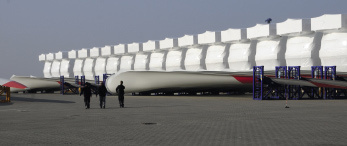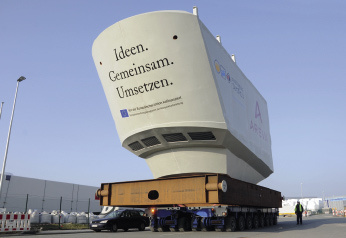SET Analysis: New Tasks – New Challenges

Future wind energy applications will evolve from the present onshore use, characterised by rather moderate circumstances, into more ‚off-the-road‘ applications. Offshore wind energy is the ?rst application to deviate from the main route. Offshore is the motor for wind energy technology innovation and with its 1.6% share of all wind power installed in the world, still in the initial deployment phase.
Many innovations in the ?eld of turbine technology, control systems, access, O&M, integrated foundation and installation techniques will be developed and will have their impacts on other applications of wind energy. The application areas which will follow offshore wind energy as major market developments will likely be cold climate and desert applications.
Wind energy reliable and cost effectiveness
It is often stated that wind energy technology is mature and under the most favourable circumstances (in terms of wind speed and grid connection options) cost effective. However, this is only true for applications on land where the atmospheric circumstances can be characterised as moderate.
We might call these applications ‚main stream‘. If the external conditions become more brutal, the wind turbine technology cannot be characterised as mature. Considering the fact that at the end of 2011 only 1.6% of the total world wide installed wind power (238,000 MW) were installed offshore illustrates the fact that even the most common ‚off-the road‘ applications of wind energy are in the initial phase of implementation.
Apart from offshore other ‘off-the-road’ applications can be identi?ed which represent a considerable market. Notably these applications include wind energy in cold climate zones (cold & humid, extreme cold & dry respectively), in desert zones (hot, dry and abrasive) and in remote, rural communities (no grid and no infrastructure available). As wind energy is a local available resource it is obvious to utilise wind also in those areas. Until now this has not been the case on a signi?cant scale, mainly for market-technical reasons. Distances to load centres are too long, wind turbines with equipment to withstand extreme conditions are too expensive and not proven, capital intensity of the market is too low. These are the main reasons for the delayed development of these applications. With the increasing availability of versatile veri?ed design tools, understanding of the overall behaviour of a wind turbine system in a wide range of external conditions and advanced materials and components, the design of wind turbines for extreme conditions is coming within reach of signi?cant commercial activities. Offshore is the ?rst example and cold climate use is the second application to emerge.
Distinct atmospheric conditions require dedicated systems. After having characterised the key developments and innovations of the mainstream application of wind energy, development needs for offshore, cold climate and desert zones will be addressed brie?y.
Main stream wind energy
- Drive train:
The classical drive trains, consisting of a slow running rotor shaft, gear box and fast running generator have become more compact, for instance by combining the main bearing of the rotor shaft and the gear box. Besides wind turbines have been developed with medium speed generators which require a gear box with a lower transmission ratio. Gear boxes mostly used in these systems are planetary gear boxes, which further feature more symmetric contact points of the tooth wheels and thus are expected to be more reliable. The ?nal stage of evolution of drive train systems consist of direct driven multi-pole slow running generators of which increased reliability is expected as one critical component, the gear box, can be avoided.
- Electrical conversion systems:
A major revolution in power electrical conversion systems was initiated with the appearance of the IGBT switching elements as the successor of thyristors. Switching frequencies could be increased considerably and at the same time switching losses were reduced. The ITGB-based power electronics allowed the use of slow(er) running generators, variable rotation speed systems in combination with pitch controlled blades and full control of power quality (reactive power, power control, minimise higher harmonics). To a certain extent wind turbines have got properties as it were a controllable power plant.
In the slip stream of the introduction of advanced power electronics, new generators were introduced: Slow running, copper based multi-pole synchronous generators go competition from permanent magnet (pm) slow and medium speed generators which are more compact compared to copper based machines. As an alternative for the rare earth based pm generators, research and development of generators with ‘high temperature‘ superconducting wiring has been initiated recently.
- Control:
The control abilities of modern wind turbines have experienced a development which might be characterised as revolutionary. Multi-parameter systems control power output, electric power requirements such as reactive power needs of the grid and fault ride through ability, safety systems and active vibration control. New sensors such as LIDAR are being introduced to determine the detailed in?ow wind ?eld of the rotor. Also new sensors and monitoring equipment is introduced for conditioning monitoring to optimise maintenance.
- Upscaling:
Although upscaling without changing the concept and the materials a wind turbine is being made of, does not result in cheaper kWh’s, wind turbines have become much bigger than the 25 meter machines from the mid 1980’s. The largest wind turbines which are now on the drawing table have rotor diameters of around 160 meters. The main reason behind the spectacular upscaling process is the availability of new (rotor) materials with a higher strength to weight ratio, improved manufacturing processes, use of advanced design tools leading to material extensive designs, leading to cost reduction in other parts of the wind turbine system, such as installation, maintenance and foundation.

Offshore
The emergence of offshore wind energy, as a result of a shortage of high potential land locations and increased public resistance against large scale wind farms on land, was the motor of innovation in the wind sector. The offshore industry needs wind turbines which are as big as possible as wind turbines are not the most important cost drivers, but foundations & support structures and offshore operations are. Innovations described in the previous paragraph mainly resulted from offshore developments. New elements of offshore wind energy include aerodynamic and structural consequences of extreme upscaling, wind farm ?ow phenomena due to the sheer size of offshore wind farms and low turbulence intensity (less mixing of the ?owing air) and the need for electrical infrastructure in the ocean.
- Size and power rating:
Offshore wind turbines will likely have diameters of 160 meters or more. The cost of exporting electricity from a wind farm to an offshore substation or, in the future, an offshore substation located at a terminal of a super grid connector constitute a substantial part of the offshore generating cost. For that reason offshore wind farms are designed for a high capacity factor (up to 0.5) to transport as many kWh’s at a rated power level which is as low as possible. This will lead to lower transport cost as the cable cost are determined by rated power and not by the amount of electricity transported. A high capacity factor further has the advantage of an increased predictability of wind farm output. Actually offshore wind turbines should have a power rating as if they were designed for low wind and structurally designed for high wind speed regimes.
- Rotor control:
Very large wind turbine blades cut through a ?eld with large turbulence structures. Only the local ?ow at certain radial section of the blade is optimal. When the pitch angle of the entire blade is changed the effect might be that the section of optimal ?ow just shifts to another radial position. Thus full blade pitch of very large wind turbines becomes less effective. As an alternative, distributed blade control is being developed, including associated sensors, activators, control strategies, materials and manufacturing methods. From initial wind tunnel tests it appeared that distributed blade control could lead to a reduction of fatigue loads in the blade root to up to 30%. [1], [2].
- Wakes and wind farm flow:
The wakes in offshore wind farms mostly are much more stable than at onshore sites because of lower turbulent mixing. There are two consequences associated with this phenomenon. The axial spacing between wind farms needs to be larger than on land in order to allow the wind speed at hub height to be supplemented to its approximate original level. The other consequence is that the dip in wind farm output power is signi?cant if the wind direction is parallel to a straight row of wind turbines. This effect can be avoided by not installing offshore wind turbines in straight rows anymore, but applying alternative lay-out patters. On land this effect is much smaller as the ambient turbulence degree is higher.
A better understanding of wake propagation in offshore wind farms provides the opportunity to develop control strategies that maximise output on a farm level, rather than maximising the output of each individual wind turbine. Analyses show that in the ?rst case a couple of percents more output can be generated compared to the latter case. This can for instance be achieved by decreasing power output of the row of wind turbines which are exposed to the undisturbed wind (thus making the ?rst row more transparent tor the wind) and thus increasing the incident wind supply to the next and following rows of wind turbines.
Electrical connection to the grid:
There is no electrical infrastructure offshore. The common way of connecting offshore wind farms to the grid is building separate export cables connecting each individual wind farm to an onshore substation. It is expected that a dedicated electrical offshore infrastructure, which can be shared with all wind farms in a certain offshore section could bring many synergetic advantages and cost reductions. This would certainly be the case if that infrastructure could be combined with offshore interconnectors which are now being realised to increase exchange of electricity between countries for better balancing supply and demand. In order to combine the trading interconnectors with the offshore wind grid, multi-terminal connector systems are being developed, based on HVDC technology. The rated power of the combined systems, however, has to be considerably larger than the trading connectors.
Transport, Installation, Maintenance – The following trends can be observed:
Installation methods evolve from installing wind turbines, subsystem by subsystem, to installing the entire structure on the foundation in one single operation, thus minimizing the offshore working time.
With the accumulating experience in shallow waters and the need to exploit deeper waters not only ?oating foundations are being designed, analysed and tested, but also gravity foundations are considered cost effective solutions for waters up to 50 meters depth.
Access is a critical parameter for achieving high availability levels of offshore wind turbines. Apart from making wind turbines more reliable, access technologies are being developed which allow working time windows of up to 90%, because access can be guaranteed up to signi?cant wave heights of 3.5 meters.
With increasing distances from offshore wind farms to the shore, dedicated offshore working harbours close to wind farms might be a cost effective alternative to presently used methods. Examples are multi-functional harbours in the ocean or ?oating harbour facilities for O&M, personnel, workshops, testing and commissioning, sub stations, etc.
Cold Climate issues
Although the population living in cold climate regions in the world is relatively low, these areas represent a signi?cant wind energy resource. In the northern tip of Norway, for instance, some 6000 MW of wind power could be installed. The category of problems wind energy in those areas is facing is surprisingly similar to offshore wind energy: Extreme external conditions, access, foundations, export of electricity, transport and installation risk levels. Some outstanding development issues include:
- Mapping probability of icing conditions
- Analysing accretion of ice on blades and other components under various icing conditions
- Analysing the aerodynamic (performance) and mechanical loading effects if blade icing occurs
- Methods of anti-icing (coatings, injecting warm air in boundary layers, etc.)
- Anti-icing methods and cost consequences
- Foundations for soil conditions varying during the seasons
Desert applications and the use of wind energy for remote and rural communities
Similar to cold climate areas, hot desert areas represent a considerable resource of wind energy. Issues to fully exploit that resource show similarities with the cold climate resource: Exporting electricity to load centres, developing dedicating wind turbines for extreme climate conditions and access. Another challenge is to use wind energy as a locally available energy source for serving remote and rural communities. It is anticipated that 1.3 billion people on earth will not have access to electricity in the foreseeable future. This evident application of wind energy did not develop yet, mainly due to lack of infrastructure, local skills, capital.

[1] UpWind Project. UpWind; design limits and solutions for very large wind turbines. Published by EWEA. March 2011. See www.ewea.org
[2] Jos Beurskens (editor & author). Converting Offshore Wind into Electricity. The Netherlands‘ contribution to offshore wind energy knowledge. We@Sea programme 2004-2010. Eburon Academic Publishers. Delft, November 2011. ISBN 978 90 5972 583 6
- Quelle:
- SET Analysis
- Autor:
- Jos Beurskens
- Email:
- hjmbeurskens@gmail.com
- Windenergie Wiki:
- Turbine, Offshore, MW
News
-
19.12.2024
Windmesse wünscht frohe Weihnachten und einen guten Rutsch ins neue Jahr!
Wir möchten uns bei unseren Mitgliedern und Geschäftspartner:innen herzlich für die gute Zusammenarbeit bedanken und freuen uns auf weitere gemeinsame Projekte in 2025. [Mehr]
-
15.10.2024
Die globale Energiewende: Der Aufstieg des Globalen Südens durch Cleantech
Neue Forschungsergebnisse zeigen, dass der Globale Süden die Cleantech-Revolution schneller vorantreibt als der Globale Norden. Mit einem hohen Potenzial für erneuerbare Energien und wachsendem Investitionsfokus auf saubere Technologien wird Cleantech zum Motor des wirtschaftlichen Wachstums im Globalen Süden. [Mehr]




